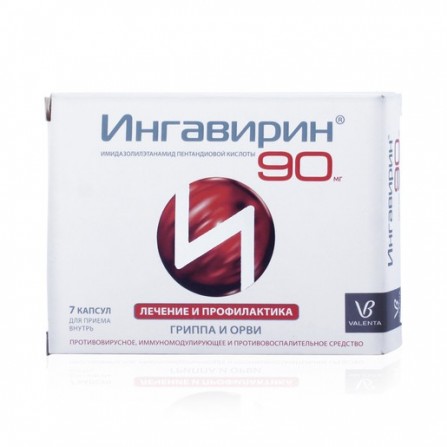More info
Active ingredients
Imidazolyl ethanamide pentanedioic acid
Release form
Capsules
Composition
In 1 capsule: Imidazolyl ethanamide pentanedioic acid (vitagluta) 90 mg. Excipients: lactose monohydrate - 90 mg, potato starch - 35.6 mg, colloidal silicon dioxide (aerosil) - 2.2 mg, magnesium stearate - 2.2 mg.
Pharmacological effect
Antiviral drug. In preclinical and clinical studies, the effectiveness of the drug Ingavirin against type A viruses (A / H1N1, including porcine A / H1N1 pdm09, A / H3N2), A / H5N1)) and type B, adenovirus, parainfluenza virus, respiratory syncytial virus; in preclinical studies: coronavirus, metapneumovirus, enteroviruses, including Coxsackie virus and rhinovirus. Ingavirin helps accelerate the elimination of viruses, reduce the duration of the disease, reduce the risk of complications. The mechanism of action is implemented at the level of infected cells by stimulating the factors of innate immunity suppressed by viral proteins. In experimental studies, in particular, it was shown that the drug Ingavirin increases the expression of the interferon receptor of the first type IFNAR on the surface of epithelial and immunocompetent cells. The increase in the density of interferon receptors leads to an increase in the sensitivity of cells to signals of endogenous interferon. The process is accompanied by the activation (phosphorylation) of the STAT1 transmitter protein, which transmits a signal to the cell nucleus to induce antiviral genes. It has been shown that under conditions of infection, the drug stimulates the production of antiviral effector protein MoxA, which inhibits the intracellular transport of ribonucleoproteins of various viruses, slowing down the process of viral replication. Ingavirin increases the blood content of interferon to the physiological norm, stimulates and normalizes reduced α-interferon, the producing ability of blood leukocytes, stimulates γ-interferon production capacity of leukocytes. It causes the generation of cytotoxic lymphocytes and increases the content of NK-T-cells with high killer activity against infected cells. The anti-inflammatory effect is due to the suppression of the production of key pro-inflammatory cytokines (tumor necrosis factor (TNF-α),interleukins (IL-1β and IL-6)), by reducing the activity of myeloperoxidase. In experimental studies, it was shown that the combined use of the drug Ingavirin with antibiotics increases the effectiveness of therapy in a model of bacterial sepsis, incl. caused by penicillin-resistant strains of staphylococcus. Experimental toxicological studies conducted indicate a low level of toxicity and a high safety profile of the drug.
Pharmacokinetics
Absorption and distribution: When used in recommended doses, the determination of the drug in the blood plasma using available techniques is not possible. In experimental studies using a radioactive label, it was found that the drug quickly enters the blood from the gastrointestinal tract and is evenly distributed throughout the internal organs. Cmax in blood, plasma blood and most organs are reached 30 minutes after drug administration. The AUC values of the kidneys, liver and lungs slightly exceed the blood AUC (43.77 μg × h / g). The AUC values of the spleen, adrenal glands, lymph nodes and thymus are below the blood AUC. The average retention time of the drug in the blood is 37.2 hours. During the course taking the drug 1 time / day, its accumulation occurs in the internal organs and tissues. At the same time, the qualitative characteristics of the pharmacokinetic curves after each injection of the drug were identical: a rapid increase in the concentration of the drug after each injection 0.5–1 h after administration and then a slow decrease to 24 hours. Metabolism and excretion: Not metabolized in the body and excreted unchanged. The main the elimination process takes place within 24 hours. During this time, 80% of the accepted dose is eliminated. During the first 5 hours, 34.8% is displayed, in the following hours - 45.2%. Of these, 77% is excreted through the intestines, and 23% through the kidneys.
Indications
Treatment and prevention of influenza A and B and other acute respiratory viral infections (adenovirus infection, parainfluenza, respiratory syncytial infection).
Contraindications
lactase deficiency, lactose intolerance, glucose-galactose malabsorption. Pregnancy; lactation period; children and adolescents under 18 years of age to show Prevention of influenza A and B and other acute respiratory viral infections;
Use during pregnancy and lactation
The use of the drug during pregnancy has not been studied. The use of the drug during lactation has not been studied, therefore, if necessary, the use of the drug during lactation should stop breastfeeding.
Dosage and administration
The drug should be taken orally, regardless of the meal. For the treatment of influenza and SARS, adults are prescribed 90 mg 1 time per day. The duration of treatment is 5-7 days (depending on the severity of the condition). The drug should be taken from the moment the first symptoms of the disease appear, preferably no later than 2 days from the onset of the disease. For the prevention of influenza and acute respiratory viral infections after contact with ill persons, adults are prescribed 90 mg 1 time / day for 7 days.
Side effects
Seldom: allergic reactions.
Overdose
Cases of drug overdose are not described.
Interaction with other drugs
Cases of interaction of the drug Ingavirin with other drugs have been identified. It is not recommended to take other antiviral drugs at the same time.
special instructions
According to the parameters of acute toxicity, the drug Ingavirin belongs to the 4th class of toxicity - Low toxic substances (it was not possible to determine the lethal doses of the drug when determining the LD50 in experiments on acute toxicity). The drug Ingavirin does not affect the reproductive function, does not have embryotoxic and teratogenic effects. Impact on the ability to drive vehicles and control mechanismsIt was not studied, however, given the mechanism of action and the profile of adverse reactions, it can be assumed that the drug does not affect the ability to drive vehicles and mechanisms.Ingavirin does not have a sedative effect, does not affect the speed of the psychomotor reaction, the drug can be used in persons of various professions, incl. requiring increased attention and coordination of movements.















